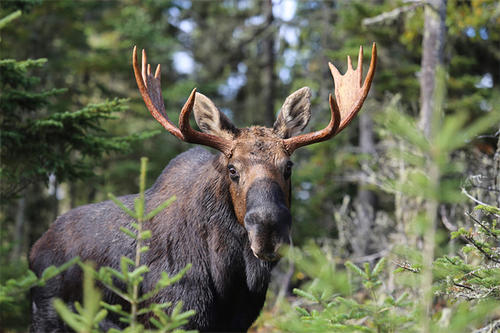
Moose have been essential to the landscape in and around Minnesota for centuries.
But recent years have not been kind to the species, as its population in Minnesota has declined by more than 50 percent since 2006. More recently, however, its numbers have stabilized, giving researchers both a respite and an opportunity to pinpoint what’s keeping this iconic creature from thriving.
University of Minnesota College of Veterinary Medicine assistant professor Tiffany Wolf is collaborating with Seth Moore, director of biology and environment at the Grand Portage Band of Lake Superior Chippewa, and other researchers to decipher whether a parasite called brainworm is the number one threat to Minnesota’s largest wild animal.
“Moose are the primary large prey species of a boreal ecosystem and are an indicator of ecosystem health,” says Moore. Moose were also once the primary subsistence species to the Grand Portage Band.
Working with a Native American tribe on a culturally vital species in hopes of solving the problems associated with that species’ decline is Wolf’s favorite part of this work.
“The long-term perspective of us being stewards and partners with nature drives the natural resource management of the tribe, and that approach aligns well with ecosystem health, where we have a holistic view that you cannot solve health issues of humans or animals in isolation of each other or the environment,” says Wolf.
Brainworm is spreading to moose in northern Minnesota through the increased population of white-tailed deer, which carry the parasite’s larvae in their feces. The larvae then mature in an intermediate host—one of several species of terrestrial snails and slugs—before becoming infectious to moose, which ingest infected snails when they browse vegetation. The matured larvae then migrate to meningeal tissue, which surrounds the moose’s brains and nervous systems. Rather than remaining there, as they do in deer, the matured larvae tunnel through moose brain and spinal tissue. The result for infected moose is neurological disease and often death.
Researchers have been studying brainworm for a long time, but recent mortality studies that Wolf and Moore have done alongside the Minnesota Department of Natural Resources have brought to light an urgent need for solutions.
“If we don’t try to do something about brainworm, it will always plague the population,” says Wolf.
Their new strategy is to use spatial analysis to pinpoint areas of habitat where moose and deer overlap. They will then identify specific landscape and climate characteristics of those areas to create a risk map of where brainworm is most likely to be transmitted.
Lastly they’ll examine genetic information from the parasite, slugs, and snails as well as movement data from deer and moose to identify vulnerabilities in transmission.
Eventually, they hope to be able to leverage natural landscape barriers to reduce brainworm transmission and help moose thrive once again.
-------
This story was adapted from Profiles, a publication of the U of M College of Veterinary Medicine. Photos by Seth Moore.
-----------------------------------------------------------------------
An added asset: neighboring populations
While the moose population is in decline on the Minnesota mainland, its population on the Lake Superior island cluster of Isle Royale National Park is booming. Because Isle Royale does not have a white-tailed deer population, it is free of brainworm. At Isle Royale, wolves have previously been the primary cause of mortality in moose, but recently the wolf population has dwindled. Moore and Wolf have helped partners at Michigan Technological University and the National Park Service to reintroduce wolves to Isle Royale in order to recreate balance among the wolf and moose populations. The researchers are also tracking the moose population there to compare them with the mainland Minnesota population.
“This is an amazingly unique opportunity,” Wolf says. “It is not often that you get to study populations in the same region that aren’t experiencing the same ecological pressures.”
-----------------------------------------------------------------------
- Categories:
- Health





